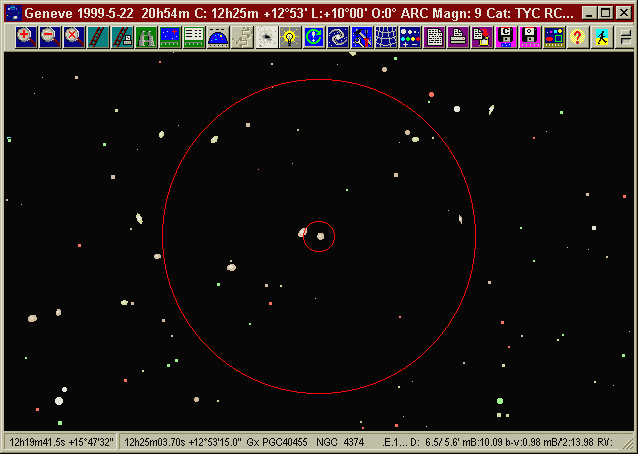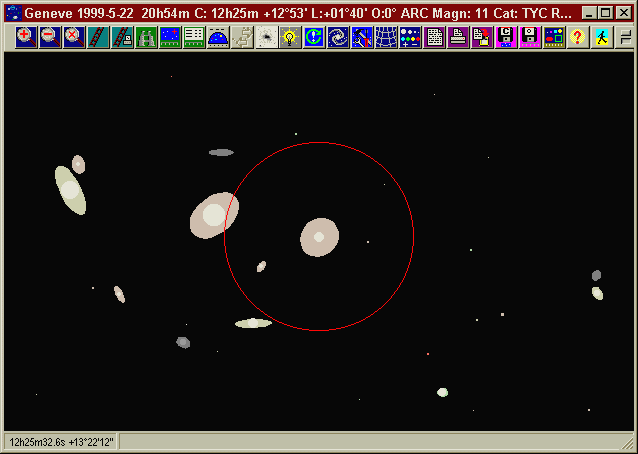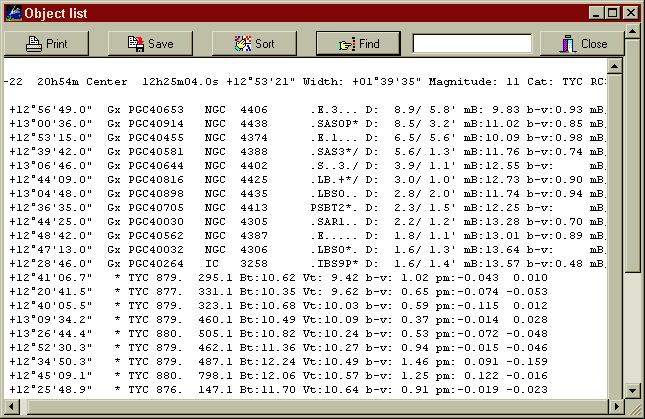Sky Charts
Galaxies observation : M84 and M86
First we produce a large scale chart to locate the galaxy field using the telescopes finder telescope.
-
Click "Catalog parameters"
 then "Stars" page.
then "Stars" page. - Check the TYCHO catalog box (or SKY2000 if not installed). Verify that "Field min" =0, and "Field max" =30.
- Check "Limit" box in "Star magnitude limit". Enter the upper magnitude that you can easily see in your finder ( i.e. 9 ) in the "8-15°" column and that of your telescope( i.e. 12) in the "0-7°".
- Select "Nebulae" page.
- Check "3' Ref. Cat. Bright Galaxies" catalog box. Verify that "Field min"=0, and "Field max"=90.
- Check the "Limit" box in "Nebulae size limit". For "8-15°" column enter "magnitude 11" and "size 1". For "0-7°" column enter "magnitude 14" and "size 0.1".
- Click "OK".
-
Click "Star appearance"

- Enter the field of view of your finder and telescope in arc minutes. (i.e. 300 and 30). Leave the third field blank if not used.
- Click "OK".
-
Click "Show Eyepiece"

-
Click "Field width"

- Drag cursor to "+10° 0' ".
- Click "OK".
-
Click "Find"

- Select "Messier".
- Then in "Cat. Id." enter 84.
- Click "OK".

Click on image for full resolution
This chart will allow identification of the objects visible in the finder without adding confusion from objects that are too faint.
You can print this chart on paper using ![]() ,
or save it in a format useable for a later reload to the program using
,
or save it in a format useable for a later reload to the program using ![]() ,
or copy to clipboard or save as image file using
,
or copy to clipboard or save as image file using ![]()
To identify all the galaxies visible in the telescope we need a more detailed chart. As we have already preset the catalog value in the first operation, this is an easy task :
-
Click "Field width"

- Drag cursor to "+1°40' ".
- Click "OK".

Click on image for full resolution
The inner circle in the galaxy drawing shows the "effective aperture",
the circle centered on the nucleus within which one-half of the total B-band
flux is emitted. It gives a better approximation of the size of the galaxy
as seen in a small telescope than the external ellipse that shows the isophotal
diameter at surface brightness level 25 B/mag2.
On this scale it will be interesting to use a more detailed star catalog
such as Tycho-Input, Guide Stars or USNO-A. Click "Catalog parameters" ![]() to change the active catalog and limiting magnitude. When the parameters
are correct for your telescope, you can record it by clicking "Save" and
give a name to the file (i.e. "LX200.opt"). Remember not to show too many
faint objects as the chart should remain simple for use at the telescope.
to change the active catalog and limiting magnitude. When the parameters
are correct for your telescope, you can record it by clicking "Save" and
give a name to the file (i.e. "LX200.opt"). Remember not to show too many
faint objects as the chart should remain simple for use at the telescope.
To obtain a list of all object in this field, simply click ![]() .
.

Click on image for full resolution